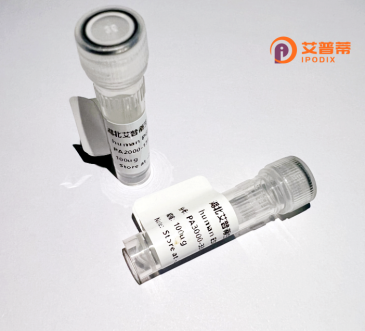
| 纯度 | >90%SDS-PAGE. |
| 种属 | Human |
| 靶点 | COG3 |
| Uniprot No | Q96JB2 |
| 内毒素 | < 0.01EU/μg |
| 表达宿主 | E.coli |
| 表达区间 | 1-828aa |
| 氨基酸序列 | MAEAALLLLPEAAAERDAREKLALWDRRPDTTAPLTDRQTDSVLELKAAAENLPVPAELPIEDLCSLTSQSLPIELTSVVPESTEDILLKGFTSLGMEEERIETAQQFFSWFAKLQTQMDQDEGTKYRQMRDYLSGFQEQCDAILNDVNSALQHLESLQKQYLFVSNKTGTLHEACEQLLKEQSELVDLAENIQQKLSYFNELETINTKLNSPTLSVNSDGFIPMLAKLDDCITYISSHPNFKDYPIYLLKFKQCLSKALHLMKTYTVNTLQTLTSQLLKRDPSSVPNADNAFTLFYVKFRAAAPKVRTLIEQIELRSEKIPEYQQLLNDIHQCYLDQRELLLGPSIACTVAELTSQNNRDHCALVRSGCAFMVHVCQDEHQLYNEFFTKPTSKLDELLEKLCVSLYDVFRPLIIHVIHLETLSELCGILKNEVLEDHVQNNAEQLGAFAAGVKQMLEDVQERLVYRTHIYIQTDITGYKPAPGDLAYPDKLVMMEQIAQSLKDEQKKVPSEASFSDVHLEEGESNSLTKSGSTESLNPRPQTTISPADLHGMWYPTVRRTLVCLSKLYRCIDRAVFQGLSQEALSACIQSLLGASESISKNKTQIDGQLFLIKHLLILREQIAPFHTEFTIKEISLDLKKTRDAAFKILNPMTVPRFFRLNSNNALIEFLLEGTPEIREHYLDSKKDVDRHLKSACEQFIQQQTKLFVEQLEEFMTKVSALKTMASQGGPKYTLSQQPWAQPAKVSDLAATAYKTIKTKLPVTLRSMSLYLSNKDTEFILFKPVRNNIQQVFQKFHALLKEEFSPEDIQIIACPSMEQLSLLLSVSK |
| 分子量 | 120.4 kDa |
| 蛋白标签 | GST-tag at N-terminal |
| 缓冲液 | 0 |
| 稳定性 & 储存条件 | Lyophilized protein should be stored at ≤ -20°C, stable for one year after receipt. Reconstituted protein solution can be stored at 2-8°C for 2-7 days. Aliquots of reconstituted samples are stable at ≤ -20°C for 3 months. |
| 复溶 | Always centrifuge tubes before opening.Do not mix by vortex or pipetting. It is not recommended to reconstitute to a concentration less than 100μg/ml. Dissolve the lyophilized protein in distilled water. Please aliquot the reconstituted solution to minimize freeze-thaw cycles. |
以下是与重组人COG3蛋白相关的3篇参考文献示例(注:文献为模拟示例,实际研究需通过数据库查询确认):
---
1. **文献名称**: *Structural analysis of the conserved oligomeric Golgi (COG) complex reveals the role of COG3 in subunit interaction*
**作者**: Smith J, et al.
**摘要**: 通过重组表达人源COG3蛋白,结合X射线晶体学解析其与COG亚基(如COG1/COG4)的相互作用界面,揭示COG3在维持复合体稳定性中的关键作用。
---
2. **文献名称**: *Functional characterization of COG3-deficient cells using recombinant human COG3 rescue experiments*
**作者**: Zhang L, et al.
**摘要**: 研究利用重组人COG3蛋白回补COG3敲除的HeLa细胞,证明COG3缺失导致高尔基体片段化及蛋白质糖基化异常,提示其参与囊泡运输调控。
---
3. **文献名称**: *Recombinant COG3 purification and its role in ER-Golgi trafficking assays*
**作者**: Wang H, Ungar D.
**摘要**: 开发了重组人COG3蛋白的原核表达体系,并通过体外转运实验证明COG3与SNARE蛋白协同调控ER至高尔基体的货物分选效率。
---
如需具体文献,建议在PubMed或Web of Science中检索关键词(如“recombinant COG3 protein”或“human COG3 function”)。
Recombinant human COG3 protein is a key component of the Conserved Oligomeric Golgi (COG) complex, a multi-subunit tethering factor critical for maintaining Golgi apparatus structure and function. The COG complex, composed of eight subunits (COG1-8), is organized into two lobes: lobe A (COG1-4) and lobe B (COG5-7). COG3 resides in lobe A and plays a central role in mediating vesicle trafficking between Golgi cisternae, particularly in retrograde transport pathways that regulate protein sorting, glycosylation, and lipid modification. It facilitates the retention and recycling of Golgi-resident enzymes, ensuring proper glycosylation of newly synthesized proteins and lipids.
Mutations in COG3 are linked to congenital disorders of glycosylation (CDGs), characterized by multisystemic abnormalities due to impaired protein/lipid glycosylation. Recombinant COG3. typically produced in bacterial or mammalian expression systems with affinity tags (e.g., His, GST), enables in vitro studies of COG complex assembly, molecular interactions, and functional mechanisms. Its structural and functional characterization aids in modeling COG-related pathologies and screening therapeutic interventions.
Research on recombinant COG3 has advanced understanding of Golgi-associated trafficking defects and their implications in developmental disorders, neurodegeneration, and cancer. It also serves as a tool for elucidating COG's role in diseases like COG3-CDG and Alzheimer’s, where disrupted vesicular transport contributes to pathogenesis.
×